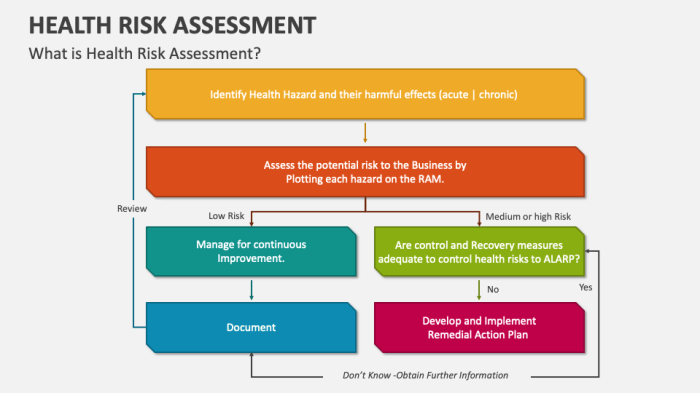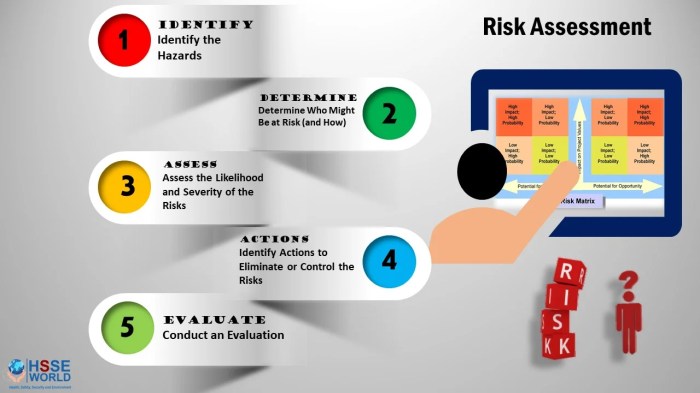
Kicking off with Risk assessment in healthcare, this opening paragraph is designed to captivate and engage the readers, providing a glimpse into the crucial role of risk assessment in ensuring patient safety and quality care within healthcare settings. As we delve deeper into the topic, we uncover the importance of identifying and managing potential risks, the challenges faced, and the strategies employed to mitigate these risks effectively.
Risk Assessment in Healthcare
Risk assessment in healthcare plays a crucial role in identifying, evaluating, and managing potential risks that could impact patient safety and the quality of care provided. By conducting thorough risk assessments, healthcare facilities can proactively address and mitigate risks, ultimately enhancing patient outcomes and reducing adverse events.
Importance of Risk Assessment in Healthcare
Risk assessment in healthcare settings is essential to ensure the safety of patients, staff, and visitors. It allows healthcare organizations to identify potential hazards, such as medication errors, infections, falls, and equipment failures, and implement strategies to prevent or minimize these risks. By systematically evaluating risks, healthcare providers can create a safer environment for patients and improve the overall quality of care.
Examples of Potential Risks in Healthcare
- Medication errors leading to adverse drug reactions
- Hospital-acquired infections due to poor hygiene practices
- Patient falls resulting in injuries
- Equipment malfunctions causing harm to patients
Role of Risk Assessment in Improving Patient Safety
Risk assessment plays a critical role in improving patient safety by identifying vulnerabilities in healthcare processes and systems. By addressing these vulnerabilities through risk mitigation strategies, healthcare providers can reduce the likelihood of errors, adverse events, and other safety incidents. This proactive approach not only enhances patient safety but also contributes to the overall quality of care delivered.
Challenges in Conducting Risk Assessments in Healthcare
- Complexity of healthcare systems and processes
- Resistance to change or implementation of new safety protocols
- Lack of standardized risk assessment tools and methodologies
- Resource constraints and competing priorities
Risk Management in Healthcare

Risk management in healthcare is a crucial process that involves identifying, assessing, and prioritizing potential risks to minimize their impact on patients, staff, and the organization as a whole. By implementing effective risk management strategies, healthcare facilities can enhance patient safety, improve quality of care, and reduce financial losses due to adverse events.
Steps in the Risk Management Process
Risk management in healthcare typically involves the following steps:
- Identification of Risks: Healthcare organizations need to proactively identify potential risks that could impact patient safety or the delivery of care.
- Assessment of Risks: Once risks are identified, they are assessed in terms of severity, likelihood of occurrence, and potential impact.
- Risk Prioritization: Risks are then prioritized based on the level of threat they pose to patients, staff, or the organization.
- Development of Risk Mitigation Strategies: Healthcare facilities develop strategies to mitigate identified risks, which may include implementing safety protocols, training staff, or updating policies and procedures.
- Monitoring and Review: Continuous monitoring and review of risk management strategies are essential to ensure their effectiveness and make adjustments as needed.
Impact of Risk Management Strategies
Effective risk management in healthcare can significantly reduce adverse events and improve patient outcomes. By identifying and addressing potential risks proactively, healthcare organizations can prevent medical errors, infections, falls, and other adverse incidents that could harm patients. Additionally, risk management strategies help enhance patient trust, reduce legal liabilities, and promote a culture of safety within the healthcare facility.
Risk Tolerance in Healthcare
Risk tolerance in healthcare refers to the level of risk that healthcare professionals and organizations are willing to accept in their operations and decision-making processes. It involves the willingness to take on certain risks while ensuring that patient safety and quality of care are not compromised.
Determining Risk Tolerance Levels
Healthcare professionals determine risk tolerance levels based on various factors such as the nature of the healthcare services provided, the potential impact of risks on patient outcomes, regulatory requirements, financial implications, and organizational culture. For example, a hospital may have a higher risk tolerance for innovative treatments that have the potential to improve patient outcomes, while maintaining a lower risk tolerance for medication errors that could harm patients.
Factors Influencing Risk Tolerance
Several factors influence risk tolerance within healthcare organizations, including the organization’s mission and values, leadership’s attitude towards risk, available resources, level of expertise among staff, external pressures such as regulatory requirements, and the overall risk management framework in place. For instance, a healthcare organization that prioritizes patient safety above all else may have a lower risk tolerance for procedures with a higher risk of complications.
Importance of Establishing Appropriate Risk Tolerance Levels
Establishing appropriate risk tolerance levels in healthcare is crucial to ensure patient safety and quality of care. By clearly defining and communicating risk tolerance levels, healthcare organizations can make informed decisions, prioritize risks that need immediate attention, allocate resources effectively, and improve patient outcomes. It also helps in creating a culture of safety and continuous improvement within the healthcare setting.
Risk Mitigation Strategies

In healthcare settings, risk mitigation strategies play a crucial role in ensuring the safety of patients, staff, and the overall quality of care provided. These strategies are designed to identify, assess, and address potential risks that could impact the delivery of healthcare services.
Common Risk Mitigation Strategies
- Implementing strict protocols and procedures: Establishing clear guidelines and protocols for different medical procedures and processes helps minimize errors and reduce risks.
- Continuous staff training: Regular training sessions for healthcare professionals can improve their skills, knowledge, and awareness of potential risks, leading to better risk management.
- Utilizing technology solutions: Adopting advanced technologies such as electronic health records (EHRs) and telemedicine can enhance communication, streamline processes, and reduce the chances of errors.
- Regular audits and inspections: Conducting routine audits and inspections help identify areas of improvement, non-compliance with regulations, and potential risks that need to be addressed promptly.
Comparing Risk Mitigation Approaches
Various approaches to risk mitigation exist in healthcare, each with its own strengths and weaknesses. While some focus on prevention through strict protocols, others prioritize response and recovery in case of adverse events. The effectiveness of these approaches often depends on the specific context and nature of the risks involved.
Role of Technology in Risk Mitigation
- Advanced analytics: Technology can enable healthcare organizations to analyze data more effectively, identify patterns, and predict potential risks before they escalate.
- Remote monitoring: Telemedicine and remote monitoring solutions allow healthcare providers to monitor patients’ health status in real-time, enabling early intervention and risk mitigation.
- Security systems: Implementing robust cybersecurity measures can protect sensitive patient data from breaches and ensure the confidentiality and integrity of healthcare information.
Successful Implementation Examples
One successful example of risk mitigation implementation is the use of barcoding systems in medication administration, which has significantly reduced medication errors in hospitals.
Another example is the implementation of fall prevention programs in long-term care facilities, resulting in a decrease in fall-related injuries among elderly residents.
In conclusion, Risk assessment in healthcare plays a vital role in enhancing patient safety, improving outcomes, and overall quality of care. By understanding the significance of risk assessment, healthcare organizations can proactively identify and address potential risks, ultimately creating a safer environment for both patients and healthcare professionals alike.
Quick FAQs
What are some common challenges faced in conducting risk assessments in healthcare?
Common challenges include data collection issues, lack of standardized assessment tools, and resistance to change within healthcare organizations.
How can technology enhance risk mitigation efforts in healthcare?
Technology can streamline data collection, automate risk analysis processes, and provide real-time monitoring of potential risks, leading to more effective risk mitigation strategies.
Why is it important to establish appropriate risk tolerance levels in healthcare?
Establishing appropriate risk tolerance levels ensures that healthcare organizations strike a balance between providing quality care and maintaining patient safety by effectively managing risks.





